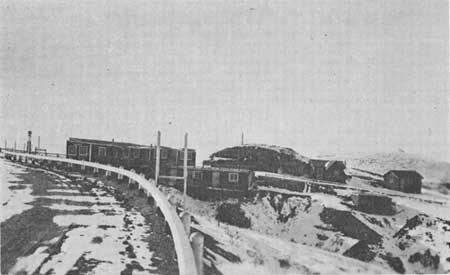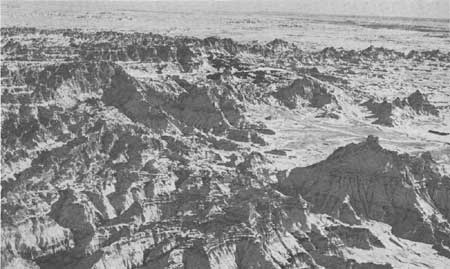|
BADLANDS History of Badlands National Monument |

|
|
THE DEPRESSION YEARS
Among local persons who worked hard toward the establishment of Badlands National Monument after it was authorized in 1929 were Ben H. Millard, the original owner of Cedar Pass Lodge; A.G. Granger of Kadoka; Leonel Jensen, local rancher; Ted E. Hustead, owner and operator of the well-known Wall Drug Store; and Dr. G.W. Mills of Wall. [113] Of these individuals, Mr. Millard made the greatest contribution to the establishment and development of the national monument. Born September 15, 1872, in Minnesota, he moved to South Dakota in 1893 with his parents. Millard entered the banking business in Sanborn County in 1899. In 1917 he sold his banking interests and entered the State of South Dakota Banking Department. On an assignment to Philip, South Dakota, Millard first saw the Badlands and became interested in them. He left the Banking Department and moved into the Badlands in 1927, homesteading below Cedar Pass on the present site of Cedar Pass Lodge, which he later built and operated. [114] Millard worked closely with Senator Norbeck on development plans for the proposed Badlands National Monument. From September 1934 through July 1936, he was employed as a local Resettlement Administration project manager. In this capacity he was responsible for federal acquisition of private lands, most of which later became part of the national monument after it was established in 1939. The alignment of the first Badlands road, alternate U.S. 16, was largely a result of his ideas. In 1931 he selected what he believed to be the most scenic route, and staked it out with the aid of his employee, E.N. "Curley" Nelson (who returned to the Badlands in 1964 to become the first concessioner of Cedar Pass Lodge). Millard and his sister, Mrs. Clara Jennings, and later his son, Herbert, operated the Pinnacles concession from about 1935 to 1950. [115] Three important parcels of land were donated by Millard to the NPS in 1941, 1946, and 1955 for inclusion in Badlands National Monument. [116] Millard died at Cedar Pass Lodge in March 1956. In special ceremonies on June 28, 1957, Millard Ridge, a prominent portion of the Badlands wall six-tenths of a mile long just east of Cedar Pass, was named and dedicated to his memory. [117] In 1929 western South Dakota, in common with most of the farm belt, had been suffering almost a decade from the deflation which followed World War I. Both farmers and ranchers had been unable to fulfill obligations assumed during an earlier period of high prices. Many of the banks of the state were forced to close. [119] With the beginning of the Great Depression in the fall of 1929, conditions became increasingly worse. A combination of disasters which included grasshopper infestations, crop failures, and drought struck the country. The south central and western counties of the state were most severely affected by these disasters. [120] Several government programs on both the federal and state levels were authorized to assist those in need. The NPS made use of a number of these programs in various ways during the 1930's. In November 1934, NPS Director Arno B. Cammerer recommended to Secretary of the Interior Harold L. Ickes that additional area be approved for inclusion in the proposed Badlands National Monument. He contended that the proposed additions, which included a portion of Sheep Mountain, were as outstanding as the area originally authorized by Congress in 1929. Wildlife problems and administrative difficulties of the originally proposed area would be lessened by the change in boundary. [121] In order to implement the proposed boundary change Mr. Cammerer recommended (1) that the President should be asked to issue an Executive Order withdrawing all public lands involved; (2) that all privately owned lands be acquired through an existing federal government relief program; and (3) that the next session of Congress be asked to establish the Badlands National Monument with the boundaries now recommended. [122] The Secretary of the Interior approved the proposal for the boundary extension and in the same month President Franklin D. Roosevelt ordered that all unreserved and unappropriated public lands in Pennington, Jackson, Fall River, and Custer Counties be
By January 1, 1935, the NPS had already obtained options for 23,000 acres from private land owners living within the proposed boundary extension area. This work was being done under the auspices of the Land Program section of the Federal Emergency Relief Administration (FERA) which had been authorized by Congress in 1933. [124] Early in April 1935, the NPS completed the "Final Report on the Badlands National Monument Extension Project, South Dakota R-1." The report included both the area previously authorized under Public Law 1021 and the proposed extension. The area, to be known as the Badlands Recreational Demonstration Project, would include 119,557.88 acres, of which 72,316.22 were privately owned. The proposed boundary extension received the support of Governor Tom Berry, Senator Norbeck, President C.C. O'Harra of the South Dakota School of Mines, and a number of prominent geologists, naturalists, educators, and others. [125] In a letter to Harry L. Hopkins, FERA Administrator, on April 15, 1935, Acting Secretary of the Interior T.A. Walters wrote:
Secretary Walters further stated that this project came within the classification of lands as stated in a memorandum to him dated July 16, 1934. In it the Director of the Land Program said:
The Secretary of the Interior recommended that the Badlands National Monument Extension be accepted as a Demonstration Recreational Project of the Land Program, FERA. The project was approved and adopted by the Land Program. The NPS expected that the cost of all the lands considered would not average more than $2.66 per acre. [128] Meanwhile, President Roosevelt, by a series of executive orders, created the Resettlement Administration, an independent agency, and transferred to it the land and related activities of the FERA. The Resettlement Administration operated until the end of 1936 when its powers, functions, and duties were transferred to the Secretary of Agriculture. Later, the name "Resettlement Administration" was changed to the Farm Security Administration. [129] The work of appraising, securing options on, and purchasing private lands, begun under the submarginal land program of the FERA, continued under the Resettlement Administration. In a 1935 letter to Assistant NPS Director Conrad L. Wirth, Senator Norbeck pointed out some of the problems and drawbacks of the land acquisition program by writing:
He went on to say that
Counties were reluctant to sell land to the federal government because this would mean withdrawal from the tax lists, thus reducing the counties' incomes. Norbeck recommended that the federal government pay more for the land by a "boost of one dollar an acre . . ." [131] Meetings were being held in various parts of the region to protest the low prices being offered. [132] The desperate situation of the times was expressed well in a letter dated September 2, 1935, from a local rancher's wife who wrote:
During the same month, the average price being offered per acre was $2.85. [134] To gain Congressional approval for the boundary extension of the proposed Badlands National Monument, the proponents secured the attachment of a rider to the Taylor Grazing Bill revision authorizing the enlargement. The grazing bill was vetoed in 1935 although there was no opposition to the rider. [135] The bill was reintroduced the following year and was passed. Approved June 26, 1936 (49 Stat. 1979), the law authorized the President to round out the authorized national monument boundary by proclamation within five years and stipulated that the entire area could not exceed 250,000 acres. Lands to be included must be "adjacent or contiguous thereto, . . . including, but not being restricted to, lands designated as submarginal by the Resettlement Administration ..." [136] This law gave the NPS sufficient flexibility in fixing a suitable boundary. Norbeck worked tirelessly in promoting every aspect of the area's development until his death in December 1936. He actively participated in securing aid from various governmental relief agencies for the land acquisition program of the area, and for building roads, erecting buildings, and other purposes. [137] As early as February 1935 Governor Tom Berry of South Dakota urged Secretary Ickes to establish the national monument formally through a presidential proclamation. He pointed out that the basic conditions of Public Law 1021 had been met: (1) a 30-mile highway, built at a cost of approximately $320,000, starting at Interior and going over Big Foot Pass and on to Sage Creek, was completed in 1935 by the state and approved by the NPS; (2) the state had acquired such privately owned lands within the area as were required by the Secretary of the Interior. [138] However, NPS Director Cammerer deferred making such a recommendation until some 9,780 acres of state lands, located within the authorized national monument boundary, had been transferred to the Service. [139] Also, it was not until three years later, in 1938, that the United States formally accepted title to 1,395.79 acres of land donated by the trustees of the Custer State Park board who acted as purchasing agents for the State of South Dakota. Senator Norbeck had been a member of this board. The land was purchased from private owners with funds authorized by the state legislature for the expressed purpose of fulfilling partial requirements of Public Law 1021. Cost to the state was approximately $12,000 for 1,280 acres of this donated land. [141] By early July 1938 Director Cammerer considered that South Dakota had met all the conditions of Public Law 1021. Under this act the federal government had acquired title to about 48,000 acres of the 50,830 authorized. Within the extension authorized by the act of June 26, 1936, the NPS included an additional 97,976 acres. In all, the boundary recommended by the Service included some 148,806 acres (later revised to 150,103.41, and still later revised again to 154,119.46 acres for the same amount of land [142]) of which the government owned 113,578.59 acres. Director Cammerer therefore asked the Secretary of the Interior to approve the establishment of the national monument and that a proclamation be submitted to the President for final approval. [143] On January 25, 1939, President Roosevelt formally proclaimed the establishment of Badlands National Monument. [144] It became the 77th national monument and the 151st area in the federal park system which is administered by the National Park Service. [145] The complicated land-ownership pattern in the national monument along with grazing would plague the NPS for years. When the area was proclaimed in 1939, the NPS administered substantial tracts of land outside the national monument's boundary. These tracts were located in the land utilization projects of the Department of Agriculture's Soil Conservation Service. On the other hand, the SCS had land utilization tracts under its jurisdiction within the boundary. [146] |
|
| ||
| <<< PREVIOUS | CONTENTS | NEXT >>> |
History of Badlands National Monument ©1968, Badlands Natural History Association badlands/sec4.htm — 04-Feb-2005 Copyright © 1968 by the Badlands Natural History Association and may not be reproduced in any manner without the written consent of the Badlands Natural History Association. | ||

